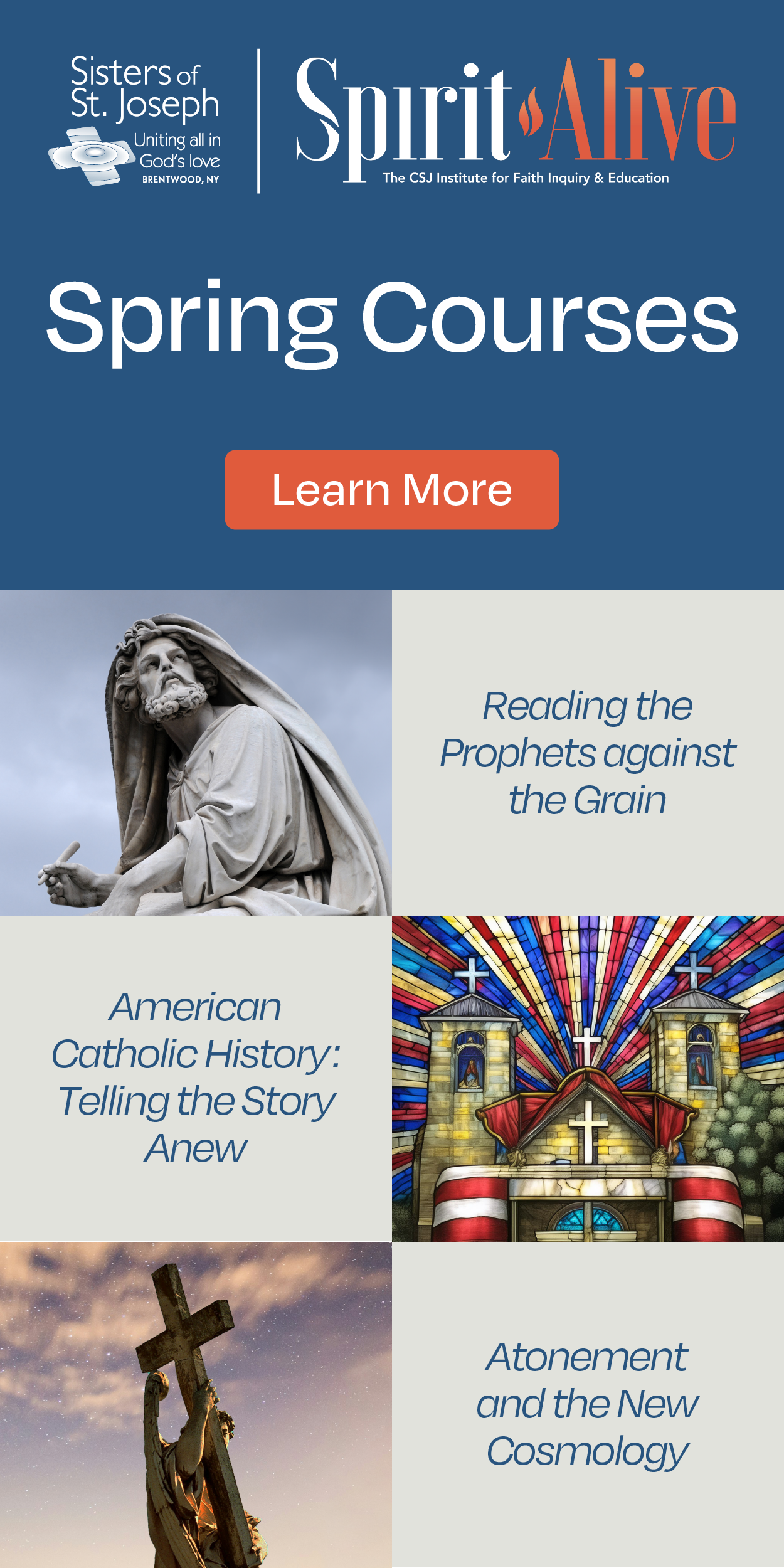With a sprinkle of water, an infant is reborn in Christ and welcomed into the Catholic community.
In some parts of the world, however, water is anything but a lifegiving force. Instead, it brings death, battles between humans and nature, and conflict among peoples over use of a precious resource.
It's a paradox, says Walter Grazer. Although in Baptism water is used as a symbol of cleansing, "in many parts of the world water brings death." Grazer, program manager of the United States Catholic Conference's Environmental Justice Program, saw some of this contradiction firsthand during a recent visit to Honduras, where "just about everything is polluted."
The Environmental Justice Program, formed in 1993, aims to help the Catholic Church in the United States address environmental and ecological concerns from a faith perspective. "The Catholic Church. . has always had a sacramental view of nature, that it's revelatory of God," Grazer says.
As water is a gift from God without which life is impossible, Catholics have a responsibility to keep water clean, to ensure the poor have access to a safe drinking supply and proper sanitation, and to sort out competing claims in areas where water is scarce, Grazer says. That responsibility, he adds, will only increase by the early 21st century, when for the first time in human history more people will live in cities than in rural areas.
In their 1991 statement Renewing the Earth, the U.S. bishops refer to, among other environmental concerns, chemicals polluting rivers and lakes, industry contributing to acid rain falling over parklands hundreds of miles away, and wetlands losing ground to development.
They reflected on Genesis-"God looked at everything he had made and he found it very good"-and issued a challenge to those made in the image and likeness of God. The bishops wrote: "Men and women . . bear a unique responsibility under God: to safeguard the created world and by their creative labor even to enhance it."
The bishops, often citing Pope John Paul II's 1990 World Day of Peace message on "the ecological crisis," refer to Catholic social teaching in developing a perspective on environmental issues. Familiar themes include a God-centered and sacramental view of the universe, a consistent respect for human life, an understanding of the equitable use of the earth's resources, an option for the poor, and a notion of development that respects human dignity and the limits of material growth.
Throughout the United States, and the world, Catholic humanitarian organizations, local dioceses, and individual parishes are putting these themes into practice as they give drink to the thirsty in a broad, environmental sense. They are providing access to safe drinking water in Third World countries, studying their own river systems in search of a sustainable future, and supporting residents of poor American neighborhoods in lawsuits against corporations accused of polluting local drinking supplies. Clean water acts "Water is so necessary to life," Grazer says, "that a number of dioceses relate to this topic." On a large scale, the Archdiocese of Detroit's River of Life Initiative has organized 44 parishes to begin to clean up and protect the city's Clinton River watershed. Their actions are part of a larger effort to deal with the economic, social, and environmental problems created by urban sprawl.
On a smaller scale, the Diocese of Rockville Centre, New York's Project Save Our Water is educating residents that the use of lawn chemicals is a possible source of contamination to the community's underground aquifers.
A group of adults and youth from Holy Cross Parish in Morgan City, Louisiana, has sent a clear message to would-be polluters of nearby Lake Palourde: "Do not dump; drains to lake."
Along with members of another Catholic parish and three Protestant congregations, Holy Cross parishioners have stenciled the message onto more than 500 city storm drains over the past year and a half.
"We're making the public aware of what they're putting down the drain"-items such as trash and grass treated with pesticides-says Catherine Holcomb, a member of Holy Cross and of the Tri-City Interfaith Stewardship Initiative.
The initiative, formed three years ago in the Louisiana communities of Morgan City, Berwick, and Patterson, encourages local parishes to include themes of environmental justice and stewardship in their worship services as well as to tackle hands-on projects, such as the storm-drain stenciling.
Everything dumped down the drains eventually runs into Lake Palourde, which is a backup water supply for the area and a popular recreational destination.
Holcomb says she came to the water issue after speaking out against environmental concerns at a nearby incinerator. "This is a way we could go in a good direction, with God," she says of the campaign.
According to Rob Gorman, executive director of the diocese's Catholic Social Services and a founding member of the interfaith initiative, water is especially important in the bayou country, where the harvesting of shrimp, crabs, and oysters is a major source of income.
Oil or chemical spills shut down drinking-water supplies, pollution closes off oyster fields, and a mixture of pesticides and extreme heat leave dead fish floating in waterways. Hazardous waste dumps in low-income communities-such as one in which the diocese has been involved in organizing residents in a lawsuit (see story on opposite page)-compound the problems, says Gorman.
"We're trying to build a whole ethic of stewardship," he explains. "You have to talk the talk and walk the walk."
Quenching thirst
Women throughout the Archdiocese of Minneapolis-St. Paul are raffling off quilts, selling tickets to motherdaughter banquets, and taking in second collections at Masses, partially to ensure safe drinking water for families around the world.
The Archdiocesan Council of Catholic Women raises about $30,000 for overseas relief efforts, according to Elaine Ploog, the council's Works for Peace chairwoman. The bulk of the money is allocated to mother-child clinics, while $1,500 is set aside specifically for Catholic Relief Services' (CRS) Water for Life projects. In developing countries, women sometimes spend four to six hours a day getting water for their families.
A typical Water for Life project, such as the one begun several years ago in San Marcos, Guatemala, is developing a potable water system. San Marcos residents credit their new system with bringing a decrease in illnesses such as malaria and intestinal worms. Earlier the farming community had relied on runoff from the mountains that was contaminated by animal waste, human waste, and pesticides seeping into the streams, says Ammanuel Moore, a CRS communications specialist who visited San Marcos in the fall.
CRS organizes residents to help with drilling bore holes, installing pipes, and setting up storage tanks to collect water for the dry months of the year. Residents provide physical labor, retrieve materials, adopt rules for the use of water, agree to participate in hygiene training, and share the cost of running the project. Many families now have faucets behind their homes that they share with other families. "It makes it easier to do daily chores," Moore says.
Roll on, Columbia
The life-giving image of water is certainly present in the Columbia River, a 1,200-mile waterway linking four western states and southeastern British Columbia. The river irrigates arid areas for farmers, historically has provided salmon and a transportation route for Native Americans, and creates recreational opportunities for outdoor enthusiasts at public parks.
But the river is also dotted with more controversial, human-made symbols: Thirteen dams breaking up the free-flowing water in Washington and Oregon, the nuclear power facility at the Hanford Reservation, and an Army depot storing poisonous gases.
Seven bishops of the Pacific Northwest and Canada, whose dioceses are touched by the Columbia River drainage, have launched an extensive pastoral letter project to address all of these often competing interests in the river. They aim to apply Catholic social teaching to economic, environmental, and social issues in a consultative process that will result in a letter to be issued in the year 2000.
"We can offer principles for people to look to the common good and the complexities of the river system" as experts and policymakers make decisions about the river and the communities it impacts, says Bishop William S. Skylstad of Spokane, who chairs the project's steering committee.
He expects the pastoral letter to address the past history of the river and what steps are necessary to heal past wrongs, such as some dams' displacement of towns and farmlands. He also expects the letter to offer a direction for good stewardship of the river.
"We are not here to demonize anyone," Skylstad says. "We are here to preserve the present moment as we look to the future."
The three-year project began in September 1997 with a series of meetings held throughout the region that featured historical, scientific, sociological, economic, cultural, and theological readings on the river. The second phase, launched in September 1998, is reflecting on the river in light of Catholic social-justice teachings as they relate to ecological degradation and economic injustice. The third and final phase will result in the proclamation and promotion of the pastoral letter.
"One of the significant things that touches us is what we have to do in terms of cleanup," Skylstad says. He refers to chemicals from silver mines in Idaho that have leached into the river system and contamination from the Hanford nuclear facility.
The bishops don't expect to render an opinion on current controversial discussions about bypassing some of the dams and allowing the river to flow freely in spots, Skylstad says. But he does expect them to acknowledge the tensions between Native Americans alarmed by the decline in salmon migrating from the Pacific Ocean and supporters of the hydroelectric power generated by the dams. The letter may also call for the development of parks to preserve the free-flowing areas of the river, he says.
"The image of water and flowing water is so strong in our history and church," Skylstad says, citing scriptural references from Ezekiel in the Old Testament to Revelation as well as the image of baptismal fonts.
"All of that speaks to water that gives us life" both spiritually and physically.
This article appered in the December 1998 issue of U.S. Catholic magazine













Add comment